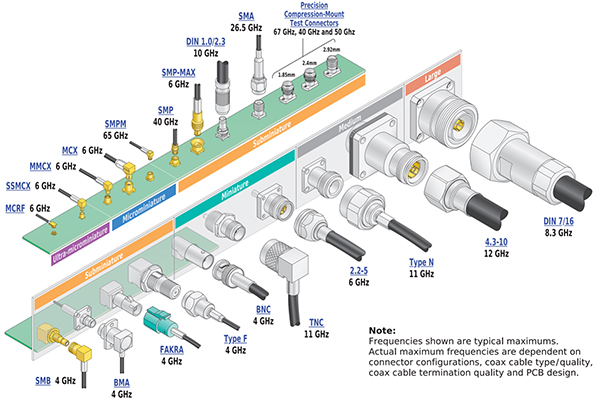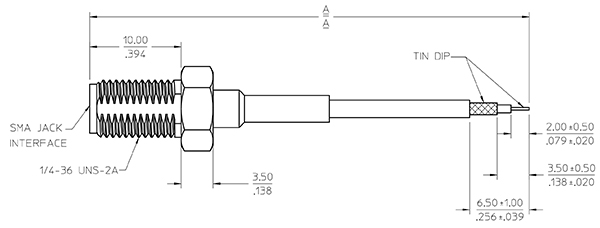RF cable assemblies are used in a wide range of applications, from well-established domains like aerospace and communications, to newer use cases like automotive, industrial, and the Internet of Things (IoT). This expanding list of applications has prompted the development of new types of RF cable assemblies, giving engineers further opportunities to optimize their RF system designs.
However, all this growth is complicating the design process. With so many assemblies on the market, it is difficult to identify the best choice for a particular application. Also, the use of RF cabling in new applications is putting unfamiliar technology in front of more designers, installers, and maintenance technicians. Along with space and environmental considerations, those groups must now become familiar with frequency compatibility, impedance matching, voltage standing wave ratio (VSWR), magnetic coupling, and shielding.
To ensure the performance and reliability of RF systems, engineers need an attentive approach and a clear roadmap of the options and potential pitfalls that await them.
Beginning with a brief overview of RF applications including their electrical characteristics, physical construction, and typical use cases, this article serves as a guide to the complex task of choosing, installing, and maintaining RF cable assemblies. Examples from Molex are introduced to illustrate key selection and usage criteria.
RF technologies span a multitude of sectors, each with its unique challenges. Frequencies range from hundreds of hertz (Hz) to tens of gigahertz (GHz). Some applications require ruggedization. Others have extremely confined physical footprints. To illustrate the diversity of use cases, consider these common applications:
Due to the growing use of RF, more engineers and designers are engaging with high-frequency circuits, many without a background in this technology. Faced with tight deadlines and budgets, they need solutions that simplify their tasks while ensuring their systems perform reliably.
That is where RF cable assemblies come in. These assemblies consist of pre-assembled connectors and cables that meet the specified performance requirements while reducing the engineering effort. Using premade RF cable assemblies can save time and cost during design and prototyping, and improve the quality and efficiency of production.
Choosing the appropriate cable assembly requires careful consideration of multiple factors. First, the assembly must be able to accommodate the frequency range of the RF signal. These can vary from a few hundred hertz to the super high frequency (SHF) band of 3 to 30 GHz or higher (Figure 1).

Figure 1: RF cable assemblies come in a wide variety of designs, which can be categorized by the size of the connector and their maximum supported frequency, among other factors. (Image source: Molex)
To achieve the desired performance, a cable assembly must handle the appropriate frequency range without significant signal loss or distortion. For example, the Society of Motion Picture and Television Engineers (SMPTE) sets stringent signal quality requirements under their 2082-1 guidelines, which limits loss to 40 decibels (dB) at half the clock frequency.
One way to meet these demands is with the Molex BNC Mini RF Cable Assemblies, which deliver high return-loss performance at frequencies of up to 12 GHz. This performance exceeds the requirements for serial transmission of 8K high-definition TV (HDTV) video, allowing for future bandwidth expansion without hardware changes.
Impedance matching is another key parameter. RF signals are susceptible to interference from incident and reflected waves caused by an impedance mismatch along the signal line. To minimize signal loss, the cable assembly should have the same impedance as the connected load, typically either 50 or 75 ohms (Ω). It is good practice to design the connectors and cables together to achieve the best match.
A real-world example of this practice is the 0897629290 assembly that pairs Molex BNC connectors with a Belden 4794R cable for high-end 75 Ω applications.
For particularly demanding applications like test and measurement, it may be necessary to carefully consider additional parameters like VSWR and insertion loss. VSWR is the ratio of an incident signal to the reflected signal that provides a measure of how efficiently RF signals are carried from source to load. Insertion loss is the amount of energy that a signal loses as it travels along a connector and cable. Figure 2 illustrates some examples of each.
|
Figure 2: Shown are examples of VSWR and insertion loss figures for efficient, low-loss, microwave-frequency cables. (Image source: Molex)
Shielding is another important consideration. Any cable carrying RF signals can act like an antenna and broadcast or receive signals, creating interference. To minimize this interference, cables need to be shielded by a grounded metallic housing (Figure 3).

Shielding material choice is influenced by a range of factors, including performance requirements, environmental conditions, and budget constraints. For example, copper is highly effective across most frequencies but also relatively heavy and costly, while aluminum is light and inexpensive but less effective and more prone to corrosion.
There is also the form of shielding to consider. Metallic braids like those on the 0897616761 MCX assembly with RG-136 cables offer excellent mechanical strength and physical protection. In contrast, foil shields are typically made of aluminum laminated to a polyester or polypropylene film for a lightweight, inexpensive, and flexible alternative. There are other types, such as spiral, tape, and combinations, which vary in terms of percentage of frequency coverage, flexibility, lifespan, mechanical strength, cost, and ease of termination.
There may also be unique application requirements to consider. For example, medical applications often involve sensors that can be affected by magnetic fields. Here, a solution like the 0897616791 MMCX cable assembly is a viable choice, as these assemblies are available in non-magnetic coupling versions for better design compatibility.
When considering physical parameters, limitations on space and routing are often the main obstacles. Consider defense applications, which are notoriously cramped. Here, a solution like the 0897611760 SSMCX cable assembly is practical. SSMCX connectors are some of the smallest on the market and are available with vertical and right-angle orientations to accommodate challenging space and routing constraints.
Designers also need to consider the minimum bend radius when selecting an assembly. Due to their complex construction, RF cables tend to be rather stiff. For situations that require tight turns, look for solutions like the flexible microwave assemblies from Molex (Figure 4). These cables are specifically designed for a smaller static bend radius.
|
Figure 4: Shown is a sampling of RF cables with a small static bend radius. (Image source: Molex)
Temperature extremes can also be an issue, particularly for outdoor applications like those in the telecom sector. For such applications, the thermoplastic jackets common on RF cable assemblies are not suitable. Instead, more durable materials are required. For example, the flexible microwave assemblies mentioned earlier use Temp-Flex fluorinated ethylene propylene (FEP) material for the jacket, which is a tough material similar to Teflon.
Vibration and shock can compromise a design, particularly in applications like aviation. To ensure reliable operation, the RF cable assemblies used must have extraordinarily secure connections. A good example is Molex’s 0732306110 cable assembly, which utilizes I-PEX’s patented MHF® LK connector locking mechanism (Figure 5).

Figure 5: The MHF LK connector system from I-PEX uses a patented locking mechanism to ensure a secure connection. (Image source: Molex)
Maintenance must be considered as part of the design process. It is important to look at the mean time between failure (MTBF) for cable assemblies and consider how to arrange a design for ease of maintenance and repair with reasonable access to those subassemblies and connections that might need the most care.
Designers should also consider creating inspection schedules for normal maintenance, and user checklists for signs that a cable assembly might need repair or replacement to proactively manage complications. Common maintenance steps include checking assemblies for wear, as well as cleaning cables and connectors to remove contaminants that could penetrate connections and degrade performance.
Finally, it’s important to evaluate the cable assembly manufacturer. Criteria include appropriate certifications, experience in producing the relevant assemblies, sufficient product options to support design flexibility, and quality assurance processes to avoid performance issues. For example, Molex has been a leading developer of cable and connector technologies with innovation supported by more than 8,100 patents and a strong reputation for quality and technical support, including a custom cable creator tool.
Selecting the right RF cable assembly is challenging as it requires an understanding and careful consideration of factors such as frequency compatibility, shielding, environmental conditions, space constraints, and maintenance. As shown, collaborating with a seasoned manufacturer that brings expertise, quality assurance, and innovation to the table can be the key to navigating these challenges, particularly for engineers and designers who are new to RF. Such a partner can guide the process of selecting, installing, and maintaining these cables to ensure that devices and systems reliably operate at their peak.
Disclaimer: The opinions, beliefs, and viewpoints expressed by the various authors and/or forum participants on this website do not necessarily reflect the opinions, beliefs, and viewpoints of DigiKey or official policies of DigiKey. Credits go out to DigiKey (2023), Molex and Kenton Wllliston.